Charles E W Bean, Diaries, AWM38 3DRL 606/275/1 - 1918 - 1938 - Part 17

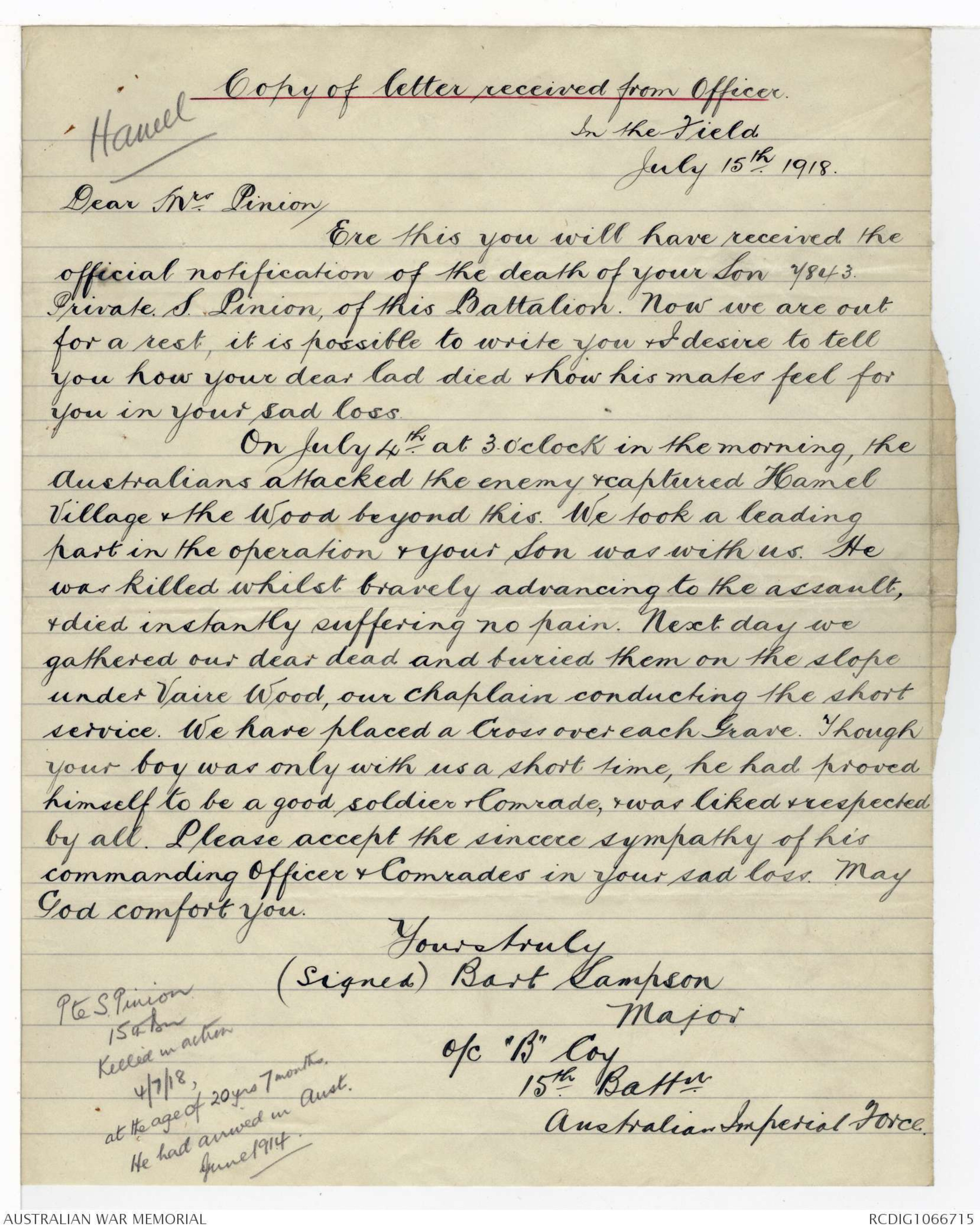
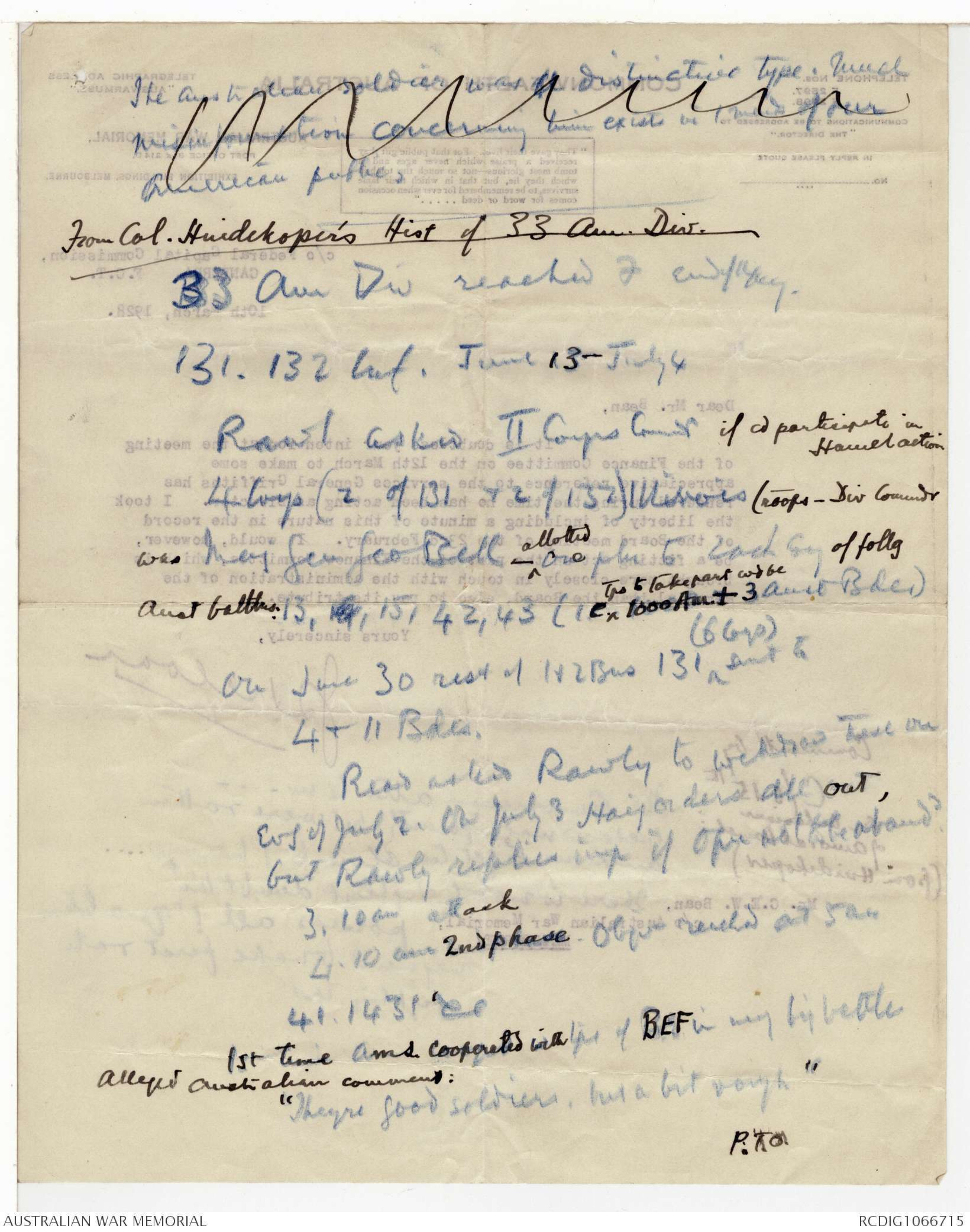
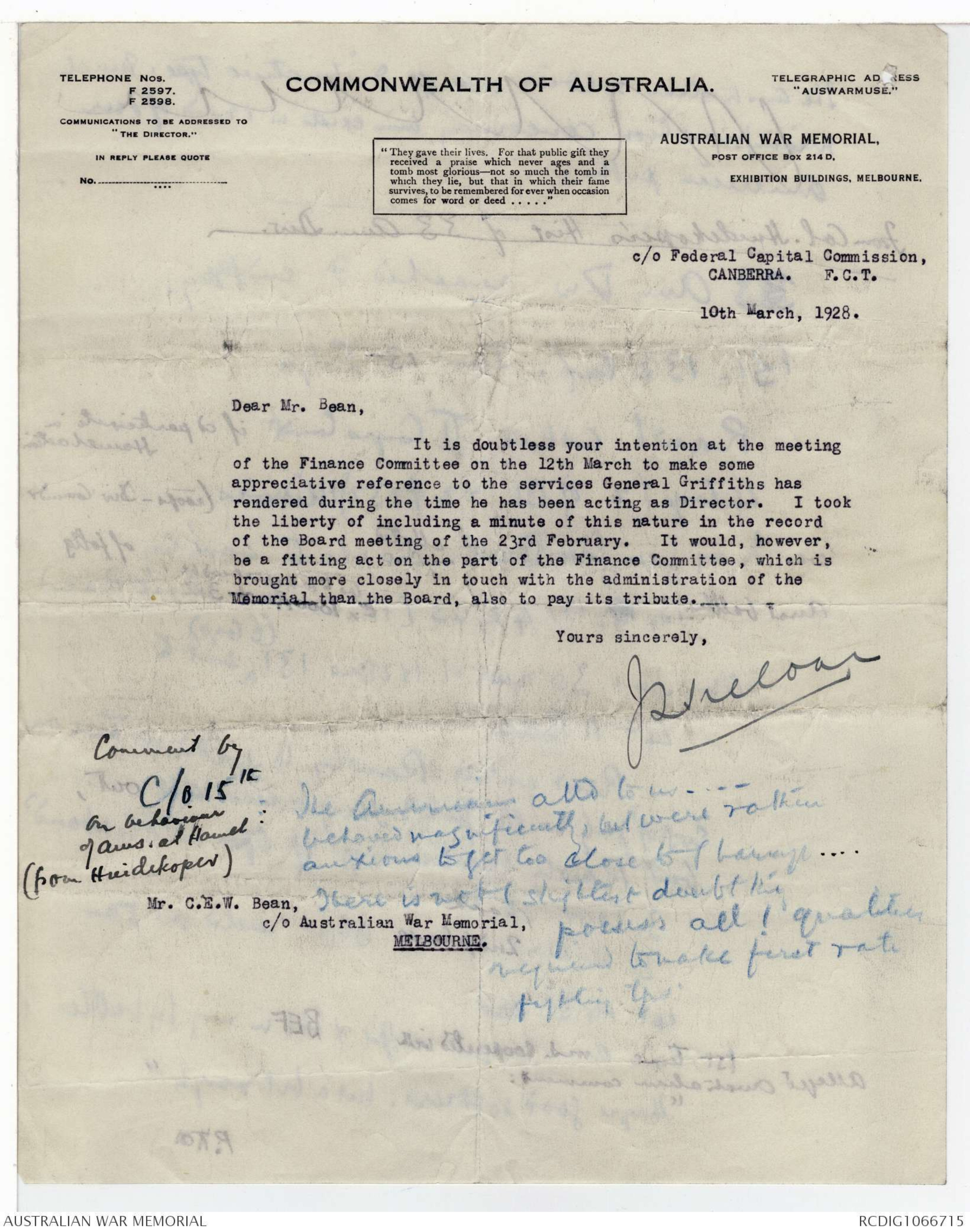
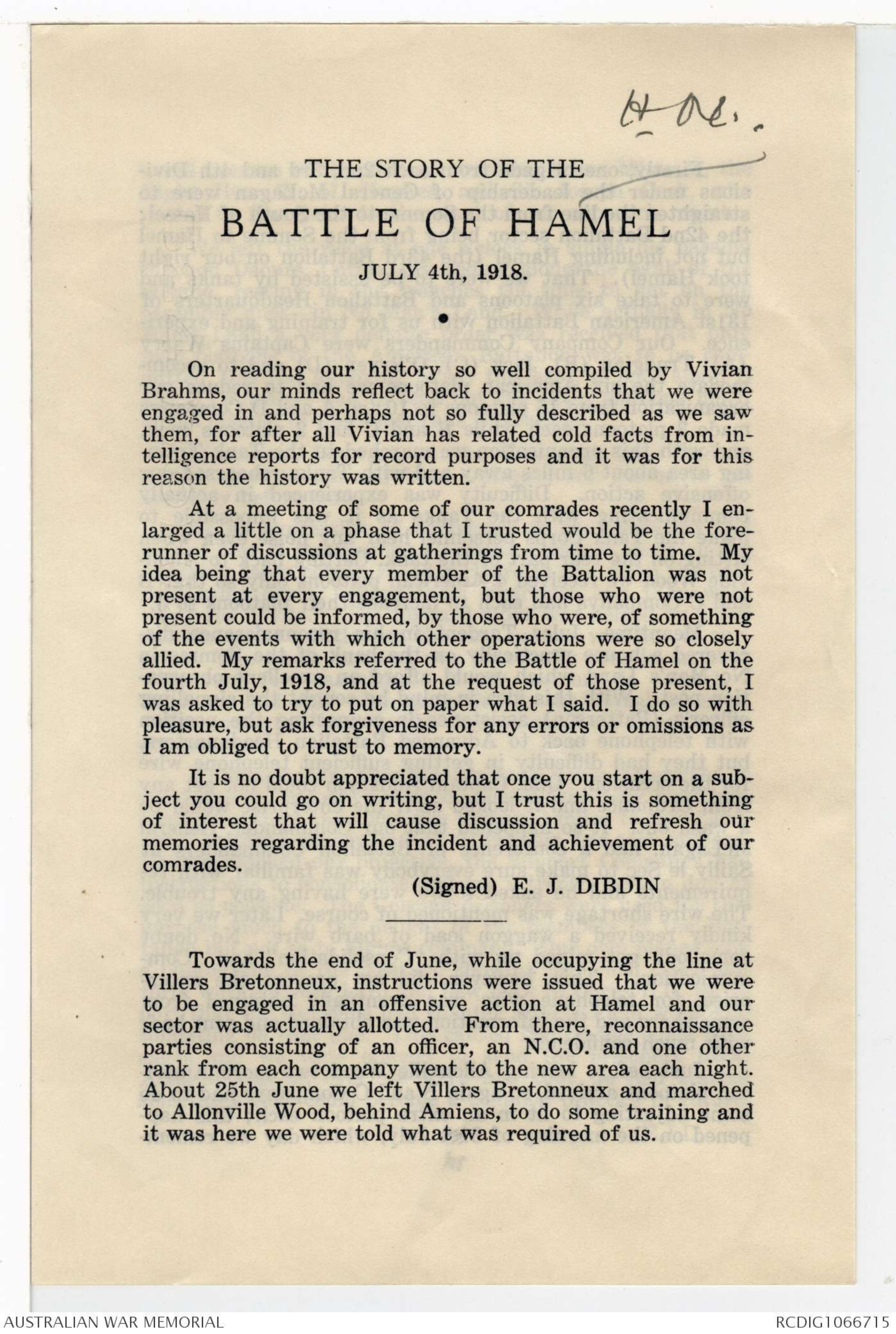
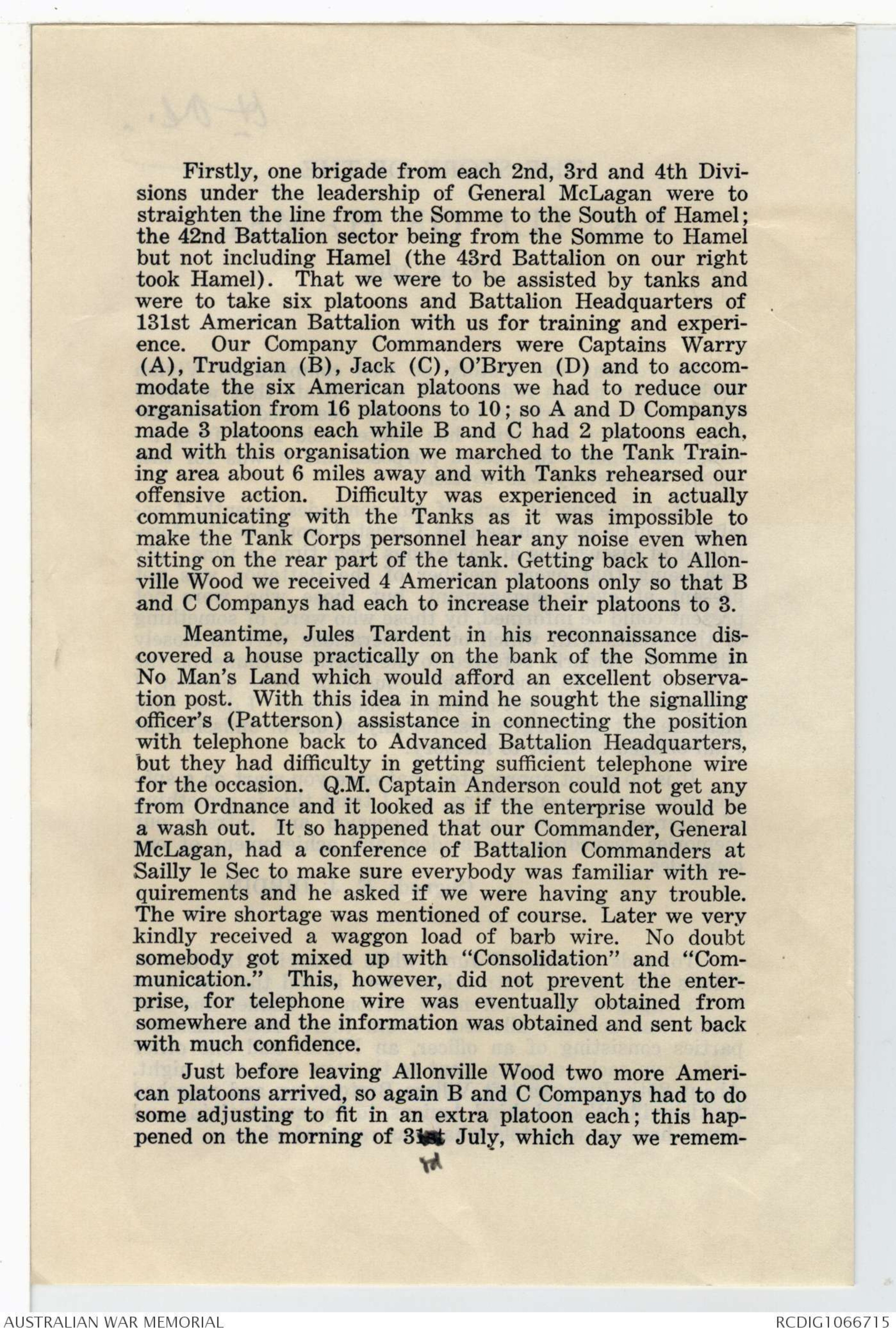
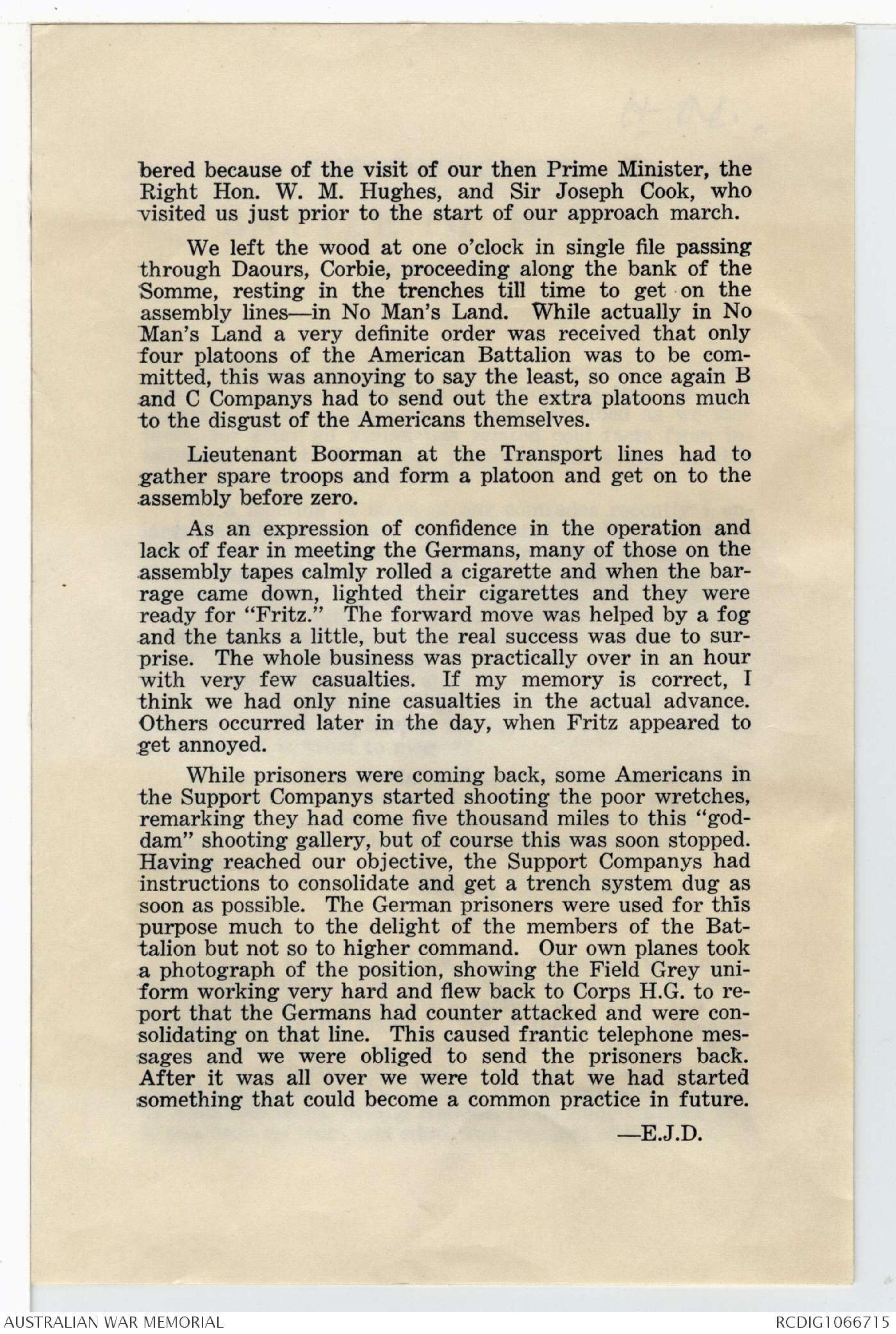
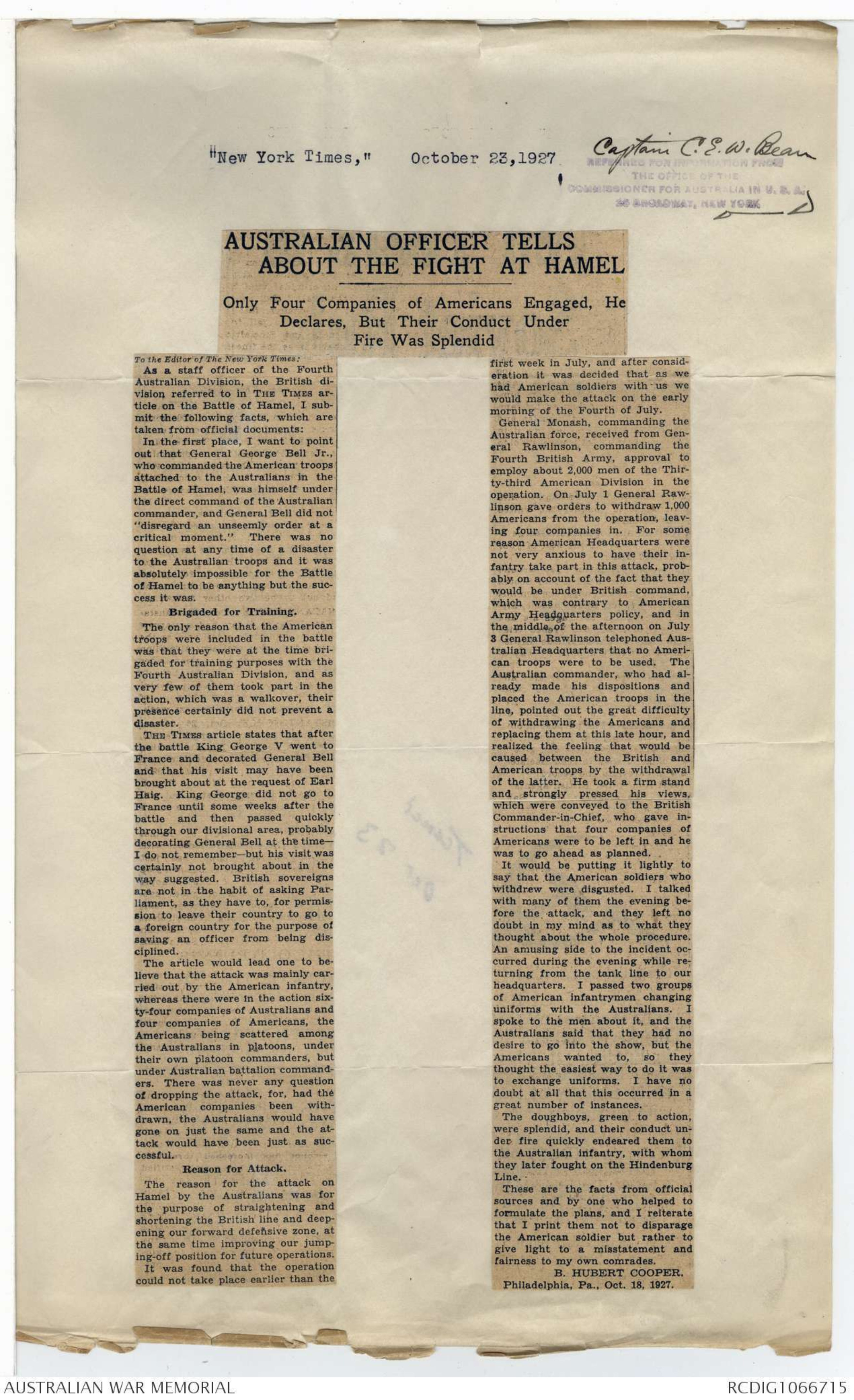
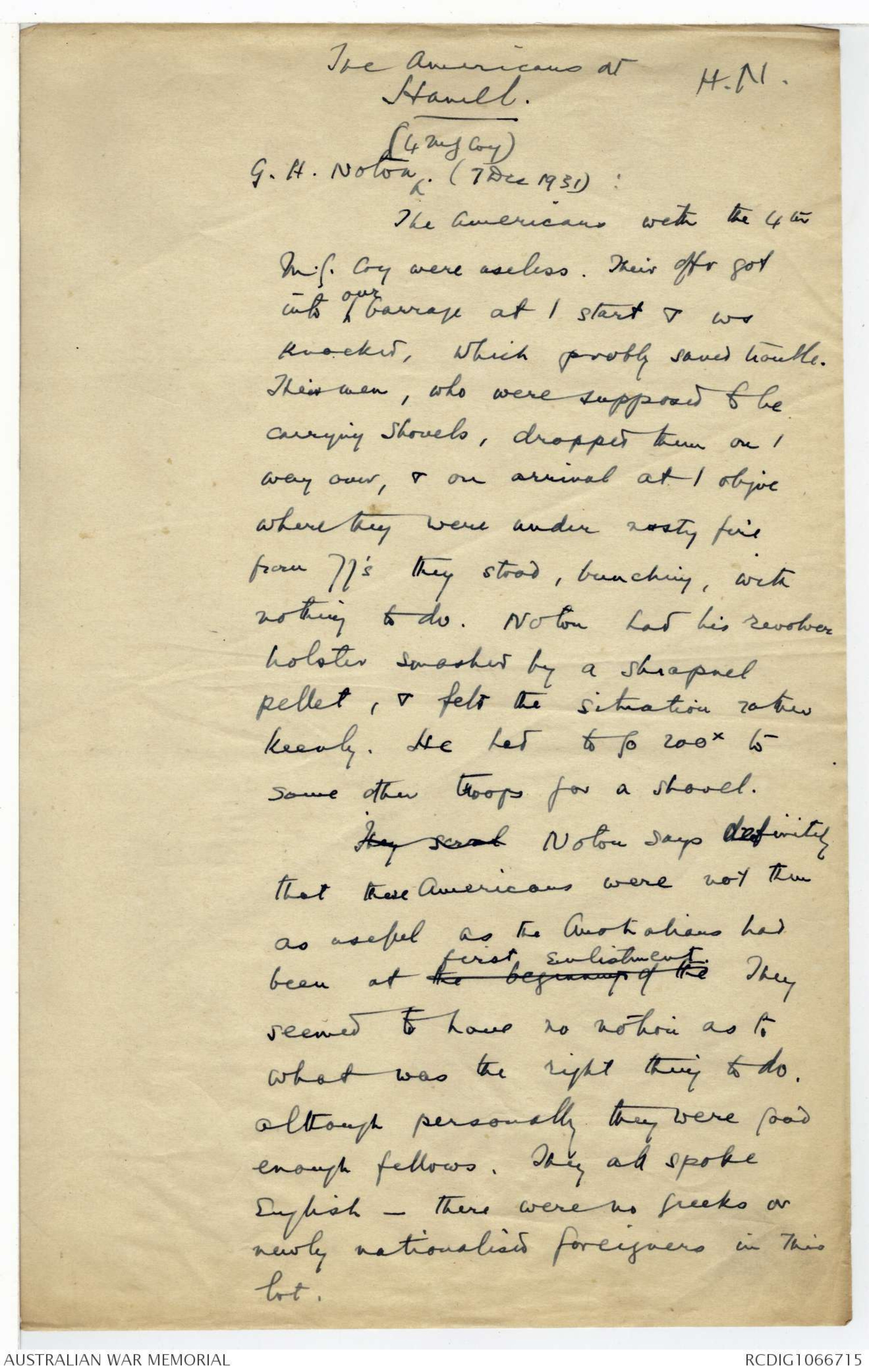
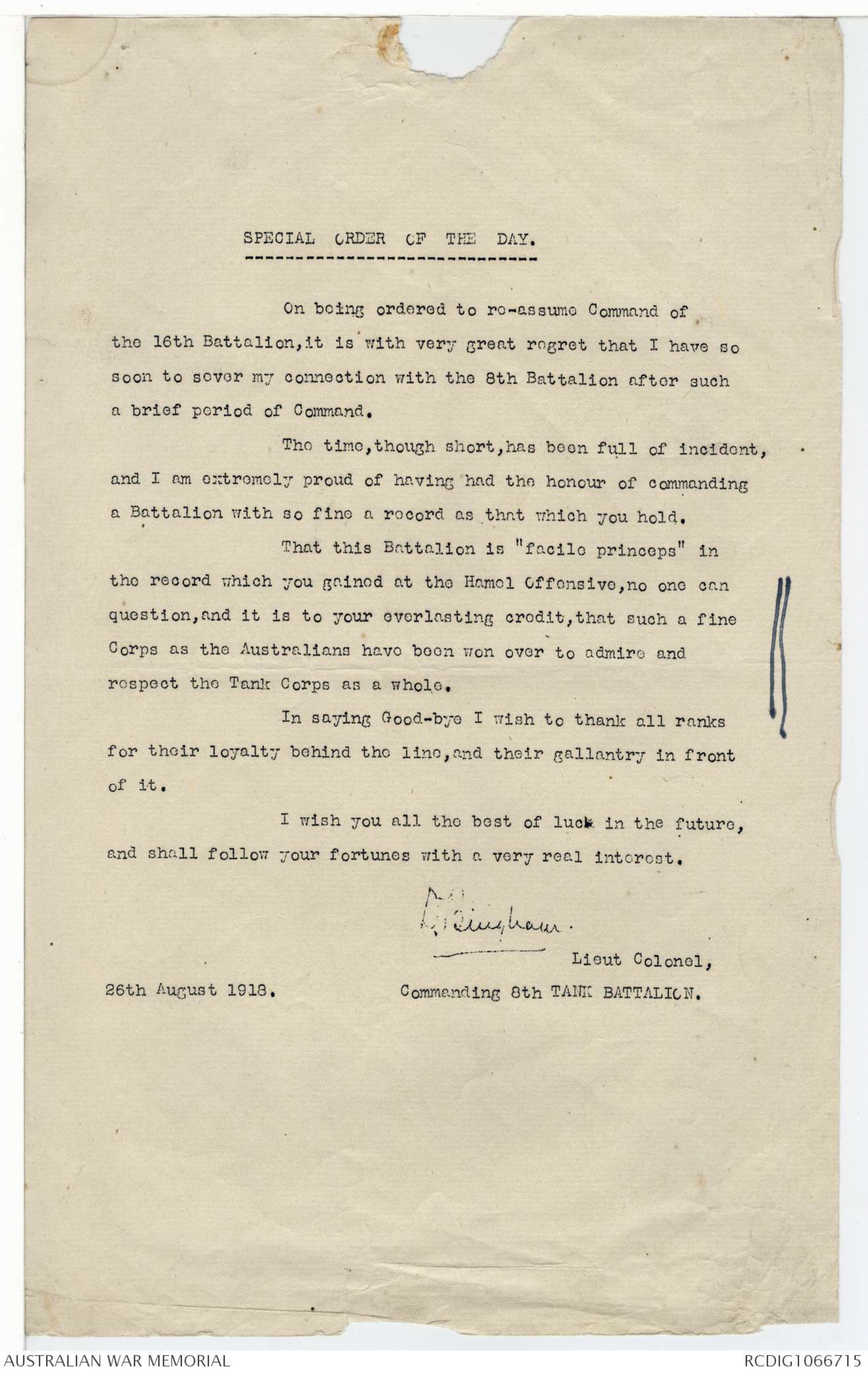
3.
smoke & dust is all
helped to keep everybody
up for the final dash
Your last para was
merely an incident.
I trust that the foregoing
meets with your desires.-
If there is anything else
you wish for please let
me know.
Yours very truly
R.A. Caroway
158 Buston Av.
North Adelaide
Copy of letter received from Officer.
[*Hamel*]
In the Field
July 15th 1918.
Dear Mrs Pinion
Ere this you will have received the
official notification of the death of your son 2/843.
Private S Pinion, of this Battalion. Now we are out
for a rest, it is possible to write you & I desire to tell
you how your dear lad died & how his mates feel for
you in your sad loss.
On July 4th at 3 o'clock in the morning, the
Australians attacked the enemy & captured Hamel
Village & the Wood beyond this. We took a leading
part in the operation & your Son was with us. He
was killed whilst bravely advancing to the assault,
& died instantly suffering no pain. Next day we
gathered our dear dead and buried them on the slope
under Vaire Wood, our chaplain conducting the short
service. We have placed a Cross over each Grave. Though
your boy was only with us a short time, he had proved
himself to be a good soldier & Comrade, & was liked & respected
by all. Please accept the sincere sympathy of his
commanding Officer & Comrades in your sad loss. May
God comfort you.
Yours truly
(Signed) Bart Sampson
Major
o/c "B" Coy
15th Battn
Australian Imperial Force
[*Pte S Pinion
15th Bn
Killed in action
4/7/18
at the age of 20yrs 7 months
He had arrived in Aust.
June 1914*]
The Australian soldier was a distinctive type. Much
[much information concerning him exists in / minds of our
American public.
From Col. Huidikoper's Hist of 33 Am. Div.
33 Am Div reached F end of May
131. 132 Inf. June 13- July 4
Rawl asked II Corps Cmmdr if cd participate in Hamel action
4 Coys ( 2 of 131 & 2 of 132) Illinois Troops - Div Commndr
was Maj Gen Leo Bell - ^ allotted one pty to each Coy of follg
Aust Battalion 13, xx, 15, 42, 43 (ie ^x Tps to take part wd be 1000 Aust & 3 Aust Bdes)
on June 30 rest of 1 & 2 Bns 131 ^ ( 6 Coys) sent to
4 & 11 Bdes.
Read asked Rawly to withdraw these on
eve of July 2. On July 3 Haig ordered all out
But Rawly replies imp if objve not to be aband?
3.10am attack
4.10am 2nd phase objve reached at 5am
41.1431 cc
1st time Ams cooperated with tps of BEF in way by battle
Alleged Australians comment:
" Theyre good soldiers but a bit rough"
P.T.O.
TELEPHONE NOS.
F2587.
F 2398.
COMMUNICATIONS TO BE ADDRESSED TO
"THE DIRECTOR."
IN REPLY PLEASE QUOTE
No. . . . . . . . . .
COMMONWEALTH OF AUSTRALIA.
TELEGRAPHIC ADDRESS
"AUSWARMUSE"
AUSTRALIAN WAR MEMORIAL.
POST OFFICE BOX 214D
EXHIBITION BUILDINGS, MELBOURNE.
"They gave their lives. For that public gift they
received the praise which never ages and a
tomb most glorious- not so much the tomb in
which they lie, but that in which their fame
survives, to be remembered for ever when occasion
comes for word or deed. . . . ."
c/o Federal Capital Commission,
CANBERRA. F.C.T.
10th March, 1928.
Dear Mr. Bean,
It is doubtless your intention at the meeting
of the Finance Committee on the 12th March to make some
appreciative reference to the services General Griffiths has
rendered during the time he has been acting as Director. I took
the liberty of including a minute of this nature in the record
of the Board meeting of the 23rd February. It would, however
be a fitting act on the part of the Finance Committee, which is
brought more closely in touch with the administration of the
Memorial than the Board, also to pay its tribute.
Yours sincerely,
J L Treloar
[*Comment by
C/O 15th
on behavior
of Aust. at Hamel
(from Huidikoper) *]
[*The Australians alld to us.....
behaved magnificently, but were rather
anxious to get too close to / barrage.....
There is not the slightest doubt they
possess all qualities
required to make first rate
fighting types
Mr. C.E.W. Bean,
c/o Australian War Memorial,
MELBOURNE
[*H.N.*]
THE STORY OF THE
BATTLE OF HAMEL
JULY 4th, 1918.
On reading our history so well compiled by Vivian
Brahms, our minds reflect back to incidents that we were
engaged in and perhaps not so fully described as we saw
them, for after all Vivian has related cold facts from intelligence
reports for record purposes and it was for this
reason the history was written.
At a meeting of some of our comrades recently I
enlarged a little on a phase that I trusted would be the forerunner
of discussions at gatherings from time to time. My
idea being that every member of the Battalion was not
present at every engagement, but those who were not
present could be informed, by those who were, of something
of the events with which other operations were so closely
allied. My remarks referred to the Battle of Hamel on the
fourth July, 1918, and at the request of those present, I
was asked to try to put on paper what I said. I do so with
pleasure, but ask forgiveness for any errors or omissions as
I am obliged to trust to memory.
It is no doubt appreciated that once you start on a subject
you could go on writing, but I trust this is something
of interest that will cause discussion and refresh our
memories regarding the incident and achievement of our
comrades.
(Signed) E. J. DIBDIN
Towards the end of June, while occupying the line at
Willers Bretonneux, instructions were issued that we were
to be engaged in an offensive action at Hamel and our
sector was actually allotted. From there, reconnaissance
parties consisting of an officer, an N.C.O. and one other
rank from each company went to the new area each night.
About 25th June we left Villers Bretonneux and marched
to Allonville Wood, behind Amiens, to do some training and
it was here we were told what was required of us.
Firstly, one brigade from each 2nd, 3rd and 4th Divisions
under the leadership of General McLagan were to
straighten the line from the Somme to the South of Hamel;
the 42nd Battalion sector being from the Somme to Hamel
but not including Hamel (the 43rd Battalion on our right
took Hamel). That we were to be assisted by tanks and
were to take six platoons and Battalion Headquarters of
131st American Battalion with us for training and experience.
Our Company Commanders were Captains Warry
(A), Trudgian (B), Jack (C), O’'Bryen (D) and to accommodate
the six American platoons we had to reduce our
organisation from 16 platoons to 10; so A and D Companys
made 3 platoons each while B and C had 2 platoons each,
and with this organisation we marched to the Tank Training
area about 6 miles away and with Tanks rehearsed our
offensive action. Difficulty was experienced in actually
communicating with the Tanks as it was impossible to
make the Tank Corps personnel hear any noise even when
sitting on the rear part of the tank. Getting back to Allonville
Wood we received 4 American platoons only so that B
and C Companys had each to increase their platoons to 3.
Meantime, Jules Tardent in his reconnaissance discovered
a house practically on the bank of the Somme in
No Man’s Land which would afford an excellent
observation post. With this idea in mind he sought the signalling
officer's (Patterson) assistance in connecting the position
with telephone back to Advanced Battalion Headquarters,
but they had difficulty in getting sufficient telephone wire
for the occasion. Q.M. Captain Anderson could not get any
from Ordnance and it looked as if the enterprise would be
a wash out. It so happened that our Commander, General
McLagan, had a conference of Battalion Commanders at
Sailly le Sec to make sure everybody was familiar with
requirements and he asked if we were having any trouble.
The wire shortage was mentioned of course. Later we very
kindly received a waggon load of barb wire. No doubt
somebody got mixed up with "Consolidation" and "Communication".
This, however, did not prevent the enterprise,
for telephone wire was eventually obtained from
somewhere and the information was obtained and sent back
with much confidence.
Just before leaving Allonville Wood two more American
platoons arrived, so again B and C Companys had to do
some adjusting to fit in an extra platoon each; this happened
on the morning of 31strd July, which day we remembered
because of the visit of our then Prime Minister, the
Right Hon. W. M. Hughes, and Sir Joseph Cook, who
visited us just prior to the start of our approach march.
We left the wood at one o’clock in single file passing
through Daours, Corbie, proceeding along the bank of the
Somme, resting in the trenches till time to get on the
assembly lines—in No Man's Land. While actually in No
Man's Land a very definite order was received that only
four platoons of the American Battalion was to be committed,
this was annoying to say the least, so once again B
and C Companys had to send out the extra platoons much
to the disgust of the Americans themselves.
Lieutenant Boorman at the Transport lines had to
gather spare troops and form a platoon and get on to the
assembly before zero.
As an expression of confidence in the operation and
lack of fear in meeting the Germans, many of those on the
assembly tapes calmly rolled a cigarette and when the barrage
came down, lighted their cigarettes and they were
ready for "Fritz." The forward move was helped by a fog
and the tanks a little, but the real success was due to surprise.
The whole business was practically over in an hour
with very few casualties. If my memory is correct, I
think we had only nine casualties in the actual advance.
Others occurred later in the day, when Fritz appeared to
get annoyed.
While prisoners were coming back, some Americans in
the Support Companys started shooting the poor wretches,
remarking they had come five thousand miles to this "goddam"
shooting gallery, but of course this was soon stopped.
Having reached our objective, the Support Companys had
instructions to consolidate and get a trench system dug as
soon as possible. The German prisoners were used for this
purpose much to the delight of the members of the Battalion
but not so to higher command. Our own planes took
a photograph of the position, showing the Field Grey uniform
working very hard and Hew back to Corps H.G. to report
that the Germans had counter attacked and were consolidating
on that line. This caused frantic telephone messages
and we were obliged to send the prisoners back.
After it was all over we were told that we had started
something that could become a common practice in future.
—E.J.D.
"New York Times,"
October 23, 1927
[*Captain C. E.W. Bean
REFERRED FOR INFORMATION FROM
THE OFFICE OF THE
COMMISSIONER FOR AUSTRALIA IN U.S.A.
56 BROADWAY, NEW YORK.*]
AUSTRALIAN OFFICER TELLS
ABOUT THE FIGHT AT HAMEL
Only Four Companies of Americans Engaged, He
Declares, But Their Conduct Under
Fire Was Splendid
To the Editor of The New York Times;
As a staff officer of the Fourth
Australian Division, the British
division referred to in THE TIMES article
on the Battle of Hamel, I submit
the following facts, which are
taken from official documents:
In the first place, I want to point
out that General George Bell Jr.,
who commanded the American troops
attached to the Australians in the
Battle of Hamel, was himself under
the direct command of the Australian
commander, and General Bell did not
"disregard an unseemly order at a
critical moment." There was no
question at any time of a disaster
to the Australian troops and it was
absolutely impossible for the Battle
of Hamel to be anything but the success
it was.
Brigaded for Training.
The only reason that the American
troops were included in the battle
was that they were at the time brigaded
for training purposes with the
Fourth Australian Division, and as
very few of them took part in the
action, which was a walkover, their
presence certainly did not prevent a
disaster.
THE TIMES article states that after
the battle King George V went to
France and decorated General Bell
and that his visit may have been
brought about at the request of Earl
Haig. King George did not go to
France until some weeks after the
battle and then passed quickly
through our divisional area, probably
decorating General Bell at the time-
I do not remember—but his visit was
certainly not brought about in the
way suggested. British sovereigns
are not in the habit of asking Parliament,
as they have to, for permission
to leave their country to go to
a foreign country for the purpose of
saving an officer from being disciplined.
The article would lead one to believe
that the attack was mainly carried
out by the American infantry
whereas there were in the action sixty-four
companies of Australians and
four companies of Americans, the
Americans being scattered among
the Australians in platoons, under
their own platoon commanders, but
under Australian battalion commanders.
There was never any question
of dropping the attack, for, had the
American companies been withdrawn,
the Australians would have
gone on just the same and the attack
would have been just as successful.
Reason for Attack.
The reason for the attack on
Hamel by the Australians was for
the purpose of straightening and
shortening the British line and deepening
our forward defensive zone, at
the same time improving our jumping-off
position for future operations.
It was found that the operation
could not take place earlier than the
first week of July, and after consideration
it was decided that as we
had American soldiers we
would make the attack on the early
morning of the Fourth of July.
General Monash, commanding the
Australian force, received from General
Rawlinson, commanding the
Fourth British Army, approval to
employ about 2,000 men of the Thirty-third
American Division in the
operation. On July 1 General Rawlinson
gave orders to withdraw 1,000
Americans from the operation, leaving
four companies in. For some
reason American Headquarters were
not very anxious to have their infantry
take part in this attack, probably
on account of the fact that they
would be under British command,
which was contrary to American
Army Headquarters policy, and in
the middle of the afternoon on July
3 General Rawlinson telephoned Australian
Headquarters that no American
troops were to be used. The
Australian commander, who had already
made his dispositions and
placed the American troops in the
line, pointed out the great difficulty
of withdrawing the Americans and
replacing them at this late hour, and
realized the feeling that would be
caused between the British and
American troops by the withdrawal
of the latter. He took a firm stand
and strongly pressed his views,
which were conveyed to the British
Commander-in-Chief, who gave instructions
that four companies of
Americans were to be left in and he
was to go ahead as planned.
It would be putting it lightly to
say that the American soldiers who
withdrew were disgusted. I talked
with many of them the evening before
the attack, and they left no
doubt in my mind as to what they
thought about the whole procedure.
An amusing aside to the incident occurred
during the evening while returning
from the tank line to our
headquarters. I passed two groups
of American infantrymen changing
uniforms with the Australians. I
spoke to the men about it, and the
Australians said they have no
desire to go into the show, but the
Americans wanted to, so they
thought the easiest way to do it was
to exchange uniforms. I have no
doubt at all that this occurred in a
great number of instances.
The doughboys, green to action,
were splendid, and their conduct under
fire quickly endeared them to
the Australian infantry, with whom
they later fought on the Hindenburg
line.
These are the facts from official
sources and by one who helped to
formulate the plans, and I reiterate
that I print them not to disparage
the American soldier but rather to
give light to a misstatement and
fairness to my own comrades.
B. HUBERT COOPER
Philadelphia, Pa., Oct. 18, 1927
[*H. N.*]
The Americans at
Hamel
G.H. Noton. ^(4 Mg Coy) (7 Dec 1931)
The Americans with the 4th
M.G. Coy were useless. Their offr got
into ^ our barrage at / start & ws
knocked, which probly saved trouble.
Their men, who were supposed to be
carrying shovels, dropped them on /
way over, & on arrival at / objve
where they were under nasty fire
from trench's they stood, bunching, with
nothing to do. Noton had his revolver
holster smasher by a shrapnel
pellet, & felt the situation rather
keenly. He had to go 200x to
some other troops for a shovel.Hey scrab Noton says definitely
that these Americans were not there
as useful as the Australians had
been at the beginning of the first enlistment. They
seemed to have no notion as to
what was the right thing to do
although personally they were good
enough fellows. They all spoke
English - there were no Greeks or
newly nationalised foreigners in this
lot.
SPECIAL ORDER OF THE DAY.
On being ordered to re-assume Command of
the 16th Battalion,it is with very great regret that I have so
soon to sever my connection with the 8th Battalion after such
a brief period of Command.
The time, though short, has been full of incident,
and I am extremely proud of having had the honour of commanding
a Battalion with so fine a record as that which you hold.
That this Battalion is "facile princeps’ in
the record which you gained at the Hamel Offensive, no one can
question, and it is to your everlasting credit, that such a fine
Corps as the Australians have been won over to admire and
respect the Tank Corps as a whole.
In saying Good-bye I Wish to thank all ranks
for their loyalty behind the line, and their gallantry in front
of it.
I wish you all the best of luck in the future,
and shall follow your fortunes with a very real interest.
CB Bingham
Lieut Colonel,
26th August 1918.
Commanding 8th TANK BATTALION.
 Sam scott
Sam scottThis transcription item is now locked to you for editing. To release the lock either Save your changes or Cancel.
This lock will be automatically released after 60 minutes of inactivity.